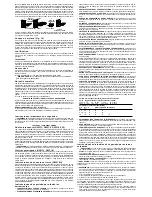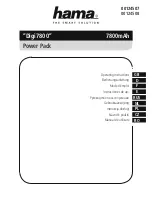
IF YOU HAVE ANY QUESTIONS OR COMMENTS ABOUT THIS OR ANY D
E
WALT TOOL,
CALL US TOLL FREE AT:
1-800-4-D
E
WALT (1-800-433-9258)
Important Safety Instructions
WARNING: When using electric tools, basic safety precautions should always be fol-
lowed to reduce risk of fire, electric shock, and personal injury, including the following:
READ ALL INSTRUCTIONS
Double Insulation(DW313, DW318, DW318-220)
Double insulated tools are constructed throughout with two separate layers of electrical insu-
lation or one double thickness of insulation between you and the tool’s electrical system.
Tools built with this insulation system are not intended to be grounded. As a result, your tool is
equipped with a two prong plug which permits you to use extension cords without concern for
maintaining a ground connection.
NOTE: Double insulation does not take the place of normal safety precautions when operat-
ing this tool. The insulation system is for added protection against injury resulting from a pos-
sible electrical insulation failure within the tool.
CAUTION: When servicing all tools, USE IDENTICAL REPLACEMENT PARTS. Repair or
replace damaged cords.
Polarized Plugs (DW313, DW318)
Polarized plugs (one blade is wider than the other) are used on equipment to reduce the risk
of electric shock. When provided, this plug will fit in the polarized outlet only one way. If the
plug does not fit fully in the outlet, reverse the plug. If it still does not fit, contact a qualified elec-
trician to install the proper outlet. Do not change the plug in any way.
Grounding Instructions (DW318G)
This tool should be grounded while in use to protect the operator from electric shock. The tool
is equipped with a 3-conductor cord and 3-prong grounding type plug to fit the proper ground-
ing type receptacle. The green (or green and yellow) conductor in the cord is the grounding
wire. Never connect the green (or green and yellow) wire to a live terminal. If your unit is intend-
ed for use on less than 150 V, it has a plug that looks like that shown in sketch A. If it is for use
on 150 to 250 V, it has a plug that looks like that shown in sketch D. An adapter, sketches B
and C, is available for connecting sketch A type plugs to 2-prong receptacles. The green-col-
ored rigid ear, lug, or the like, extending from the adapter must be connected to a permanent
ground, such as a properly grounded outlet box. No adapter is available for a plug as shown
in sketch D. ADAPTER SHOWN IN FIGURES B and C IS NOT FOR USE IN CANADA.
Safety Instructions For All Tools
•
KEEP WORK AREA CLEAN. Cluttered areas and benches invite injuries.
•
CONSIDER WORK AREA ENVIRONMENT. Don’t expose power tools to rain. Don’t use
power tools in damp or wet locations. Keep work area well lit. Do not use tool in presence
of flammable liquids or gases.
•
GUARD AGAINST ELECTRIC SHOCK. Prevent body contact with grounded surfaces. For
example; pipes, radiators, ranges, and refrigerator enclosures.
•
KEEP CHILDREN AWAY. Do not let visitors contact tool or extension cord. All visitors
should be kept away from work area.
•
STORE IDLE TOOLS. When not in use, tools should be stored in dry, and high or locked-
INSTRUCTION MANUAL
GUIDE D'UTILISA
TION
MANUAL
DE INSTRUCCIONES
DW313,DW318,DW318G, DW318-220
V
ariable Speed Orbital Jig Saws
Scies sauteuses excentriques à régulateur de vitesse
Sierras caladoras con velocidad variable orbital
INSTRUCTIVO DE OPERACIÓN, CENTROS DE SER
VICIO
Y
PÓLIZA
DE GARANTÍA.
ADVERTENCIA:
LÉASE ESTE INSTRUC-
TIVO
ANTES DE USAR EL
PRODUCT
O.
Questions? See us on the W
orld Wide W
eb at www
.dewalt.com
D
E
WALT Industrial Tool Co., 701 East Joppa Road, Baltimore, MD 21286
(XXX-XX) Form No.384014-01 DW313 Copyright © 2003
The following are trademarks for one or more D
E
WALT power tools: the yellow and black color scheme; the “D” shaped air
intake grill; the array of pyramids on the handgrip; the kit box configuration; and the array of lozenge-shaped humps on the
surface of the tool.
up place — out of reach of children.
•
DON’T FORCE TOOL. It will do the job better and safer at the rate for which it was intend-
ed.
•
USE RIGHT TOOL. Don’t force small tool or attachment to do the job of a heavy-duty tool.
Don’t use tool for purpose not intended.
•
DRESS PROPERLY. Do not wear loose clothing or jewelry. They can be caught in moving
parts. Rubber gloves and non-skid footwear are recommended when working outdoors.
Wear protective hair covering to contain long hair. Air vents often cover moving parts and
should also be avoided.
•
USE SAFETY GLASSES. Also use face or dust mask if cutting operation is dusty.
•
DON’T ABUSE CORD. Never carry tool by cord or yank it to disconnect from receptacle.
Keep cord from heat, oil, and sharp edges.
•
SECURE WORK. Use clamps or a vise to hold work. It’s safer than using your hand and it
frees both hands to operate tool.
•
DON’T OVERREACH. Keep proper footing and balance at all times.
•
MAINTAIN TOOLS WITH CARE. Keep tools sharp and clean for better and safer perform-
ance. Follow instructions for lubricating and changing accessories. Inspect tool cords peri-
odically and if damaged, have repaired by authorized service facility. Inspect extension
cords periodically and replace if damaged. Keep handles dry, clean, and free from oil and
grease.
•
DISCONNECT OR LOCK OFF TOOLS when not in use, before servicing, and when
changing accessories, such as blades, bits, cutters.
•
REMOVE ADJUSTING KEYS AND WRENCHES. Form habit of checking to see that keys
and adjusting wrenches are removed from tool before turning it on.
•
AVOID UNINTENTIONAL STARTING. Don’t carry tool with finger on switch. Be sure switch
is off when plugging in.
•
EXTENSION CORDS. Use only 3-wire extension cords that have 3-prong grounding-type
plugs and 3-pole receptacles that accept the tool’s plug. Replace or repair damaged cords.
Make sure your extension cord is in good condition. When using an extension cord, be sure
to use one heavy enough to carry the current your product will draw. An undersized cord will
cause a drop in line voltage resulting in loss of power and overheating. The following table
shows the correct size to use depending on cord length and nameplate ampere rating. If in
doubt, use the next heavier gage. The smaller the gage number, the heavier the cord.
Minimum Gage for Cord Sets
Volts
Total Length of Cord in Feet
120V
0-25
26-50
51-100
101-150
240V
0-50
51-100
101-200
201-300
Ampere Rating
More Not
more
AWG
ThanThan
0
-
6
18
16
16
14
•
OUTDOOR USE EXTENSION CORDS. When tool is used outdoors, use only extension
cords intended for use outdoors and so marked.
•
STAY ALERT. Watch what you are doing. Use common sense. Do not operate tool when you
are tired.
•
CHECK DAMAGED PARTS. Before further use of the tool, a guard or other part that is
damaged should be carefully checked to determine that it will operate properly and perform
its intended function. Check for alignment of moving parts, binding of moving parts, breakage
of parts, mounting, and any other conditions that may affect its operation. A guard or other
part that is damaged should be properly repaired or replaced by an authorized service center
unless otherwise indicated elsewhere in this instruction manual. Have defective switches
replaced by authorized service center. Do not use tool if switch does not turn it on and off.
Additional Safety Instructions for Jig Saws
•
CAUTION: When cutting into walls, floors or wherever live electrical wires may be
encountered, DO NOT TOUCH ANY METAL PARTS OF THE TOOL! Hold the tool only by
insulated grasping surfaces to prevent electric shock if you cut into a live wire.
•
KEEP HANDS AWAY from cutting area. Never reach underneath the material for any rea-
son.
•
KEEP BLADES SHARP. Dull blades may cause the saw to swerve or stall under pressure.
CAUTION: Wear appropriate hearing protection during use. Under some conditions and
duration of use, noise from this product may contribute to hearing loss.
WARNING: Some dust created by power sanding, sawing, grinding, drilling, and other con-
struction activities contains chemicals known to cause cancer, birth defects or other reproduc-
tive harm. Some examples of these chemicals are:
• lead from lead-based paints,
• crystalline silica from bricks and cement and other masonry products, and
• arsenic and chromium from chemically-treated lumber (CCA).
Your risk from these exposures varies, depending on how often you do this type of work. To
reduce your exposure to these chemicals: work in a well ventilated area, and work with
approved safety equipment, such as those dust masks that are specially designed to filter out
microscopic particles.
•
Avoid prolonged contact with dust from power sanding, sawing, grinding, drilling, and other
construction activities. Wear protective clothing and wash exposed areas with soap and
water. Allowing dust to get into your mouth, eyes, or lay on the skin may promote absorp-
tion of harmful chemicals.
SAVE THESE INSTRUCTIONS
Motor
Your D
E
WALT tool is powered by a D
E
WALT-built motor. Be sure your power supply agrees
with the nameplate marking.
Volts 50/60 Hz or “AC only” means your tool must be operated only with alternating current and
never with direct current.
Voltage decrease of more than 10% will cause loss of power and overheating. All D
E
WALT
tools are factory tested; if this tool does not operate, check the power supply.
Variable Speed Switch (Fig. 1)
This switch has a button “A”, mounted in the trigger, which can be rotated to vary the blade
strokes-per-minute (S.P.M.).
a. For “Free Hand” speed control (the further the trigger is depressed, the higher the S.P.M.),
rotate the button in the “HI” direction (clockwise) until it stops.
b. To set the trigger switch to produce a selected speed each time the trigger is squeezed,
first rotate the button toward “HI” until it stops. Then fully depress the trigger, press in the
locking button “B”, and release the trigger. The tool will stay “ON”. Now, rotate the button
“A” toward “LO” and you will notice a decrease in speed. Continue rotating the button until
desired speed is obtained. Pull trigger and release to turn the tool “OFF”. At this setting the
saw will run at the selected speed each time the trigger is pulled and the trigger may be
locked “ON” at the selected speed.
Straight Line or Orbital Cutting Action (DW318,
DW318G, DW318-220)
For cutting softer materials your saw features orbital cutting action. Soft materials, like wood
and plastic, permit deep penetration of individual saw teeth. The orbital action thrusts the blade
forward on the cutting stroke and greatly increases cutting speed over conventional jig saws.
Harder materials like metal should be cut using the straight line cutting action or a very low
orbital setting. To select straight line or orbital cutting adjust the lever on the saw as shown in
Figure 2.
Bevel Cutting Adjustment
Bevel cuts may be made at any angle between 0° and 45°. The shoe is adjusted by loosening
the screw on the bottom of the tool (Fig. 3) and rotating the shoe to the desired angle. After
setting the shoe, tighten the screw firmly and use saw in the normal manner.
NOTE: One hand on the saw body and the other on the edge of the saw shoe, well back from
the blade, may be necessary to maintain accurate cutting.
A
B
C
D
GROUNDING PIN
GROUNDED
OUTLET
BOX
GROUNDING
MEANS
GROUNDING PIN
ADAPTER























